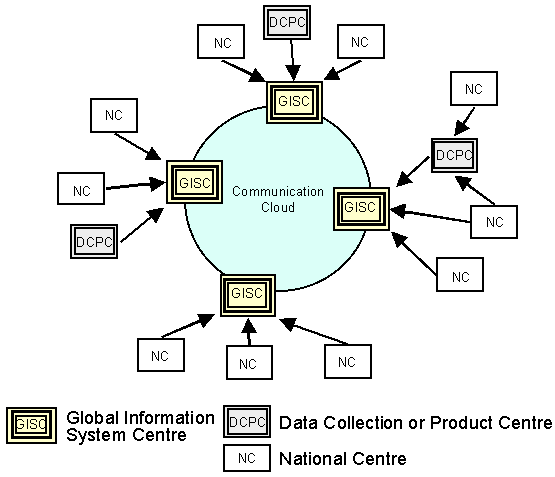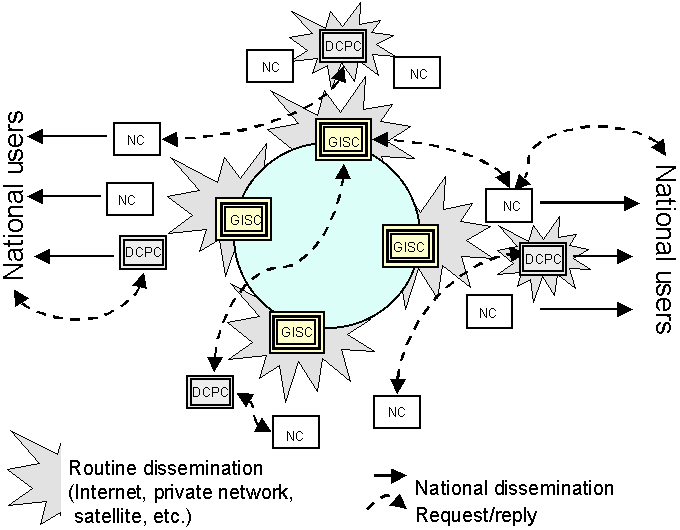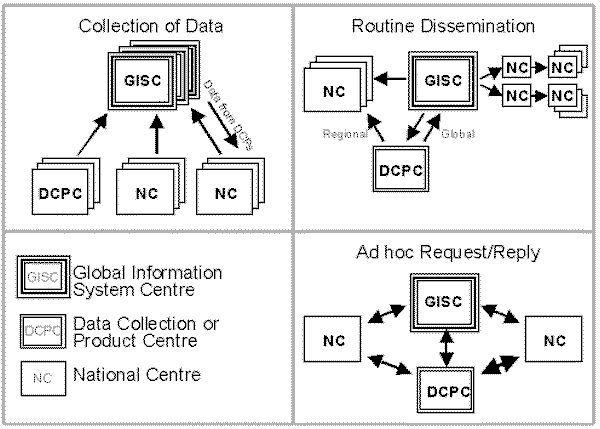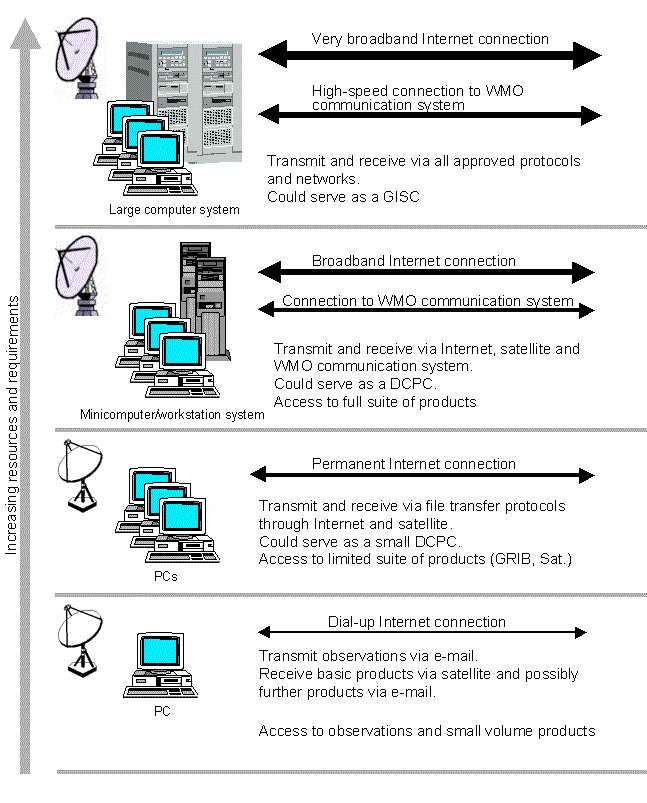
Figure 1. Information collection

Figure 2. Information distribution

Figure 3. Overview of communication topologies
Global Information System Centres
Interprogramme Task Tteam on Future WMO Information Systems
August 2001
1. The Future WMO Information System should provide an integrated approach to meeting the requirements of:
The system should be:
The system should also support:
2. Routine collection and dissemination should be accomplished via a "push" system, which could be implemented via a combination of technologies. It could include store and forward systems (which could include multiple levels organised an a tree structure), point to point communications (including use of simple technologies such as e-mail) and satellite DCP and broadcasts. Push systems are the most appropriate approach for both the routine collection of observations and the routine dissemination of observations and other products. However, the collection of observations from the many possible suppliers and dissemination of products from a few suppliers to many recipients are different problems best met through different logical topologies. Furthermore, distribution of ad hoc non-routine products should be accomplished via request/reply or "pull" systems. The "push" and "pull" systems, operating in parallel, should be available to all users of WMO data and products.
3. The Future WMO Information System should ensure coordinated development and operation of the participating systems through reliance on international protocols and standards and off-the-shelf software.
4. The Future WMO Information System will continue to rely upon the WMO communication system to provide highly reliable and timely delivery of data and products. Currently, this requires a private network but this may change as public communications services evolve.
5. The system would define participating centres according to their functions and responsibilities. The system would include three levels of responsibilities: Global Information System Centres, Data Collection or Product Centres and National Centres. It should be noted that this is a logical description and that one physical centre could perform the functions of all of the centres defined. Likewise, several physical centres could cooperate to perform the functions of a single logical centre.
6. The flow of information between these centres is illustrated in figures 1 through 3. Figure 1 outlines the collection of observations and products, Figure 2 illustrates the dissemination of products (both routine and non-routine), and Figure 3 provides a simplified view of the various categories of information flow.
7. It is envisioned that participating centres would span a range of capabilities. Less developed centres with less demanding requirements could be successfully implemented with Personal Computers and dial-up Internet connections, provided they receive basic products via satellite. As resources and requirements increase, centres could equipped with increased capabilities as illustrated in Figure 4.

Figure 1. Information collection

Figure 2. Information distribution

Figure 3. Overview of communication topologies
Global Information System Centres
8. Several (perhaps 4 to 10) Global Information System Centres (GISC) would form the top level of the Future WMO Information System. These centres would collect all observations and products intended for global distribution from supplying centres within their area of responsibility. Each supplier, which could be an NMHS, organisation (e.g. ARGOS, ARINC), research project, et cetera, would send its observations to its designated GISC. Observations would be combined into large aggregated datasets. The GISC would then forward its datasets to all of the other GISCs. The collection of observations would thus be organised into a series of star networks connected by a logical ring between the GISCs at the top. It is not considered necessary to standardise the physical links and protocols to be used between all of the suppliers and collectors. These could instead be decided by bilateral agreement to best match the requirements and capabilities of the parties involved. This approach is currently used between a number of NMHS with effective results.
9. GISCs would usually be located within or closely associated with a centre running a global data assimilation system or having some other global commitment. However, the proposed architecture does not dictate that this be a requirement.
10. Dissemination of information through a store-and-forward based push system implemented as a single layer would, in many cases, require excessive resources at some centres. Therefore dissemination would probably be best addressed through a variety of technologies including hierarchical store and forward systems similar to the current GTS message switches, satellite broadcast, and perhaps network multicast. High capability recipients requiring large-volume products could be served by one mechanism while less developed recipients with less demanding requirements could be served by another.
11. The responsibilities of a GISC can be summarised as follows. Each GISC would:
Data Collection or Product Centres
12. Several dozen centres would serve as Data Collection or Product Centres (DCPC). Existing World Meteorological Centres and Regional/Specialized Meteorological Centres would function as DCPCs. However, many additional centres would also serve as DCPCs. This would include suppliers of special observations (e.g. ARGOS, ARINC), research projects, and centres producing products related to a specific discipline. DCPCs would:
National Centres
13. National Centres would form the foundation of the Future WMO Information System. Many National Centres would be part of an NMHS but others would have national responsibility for functions falling within WMO Programmes but located outside of the NMHS. The participation of the centres would be coordinated through the national Permanent Representative to WMO. National Centres would:

Figure 4. Capabilties of centres in response to increasing requirements